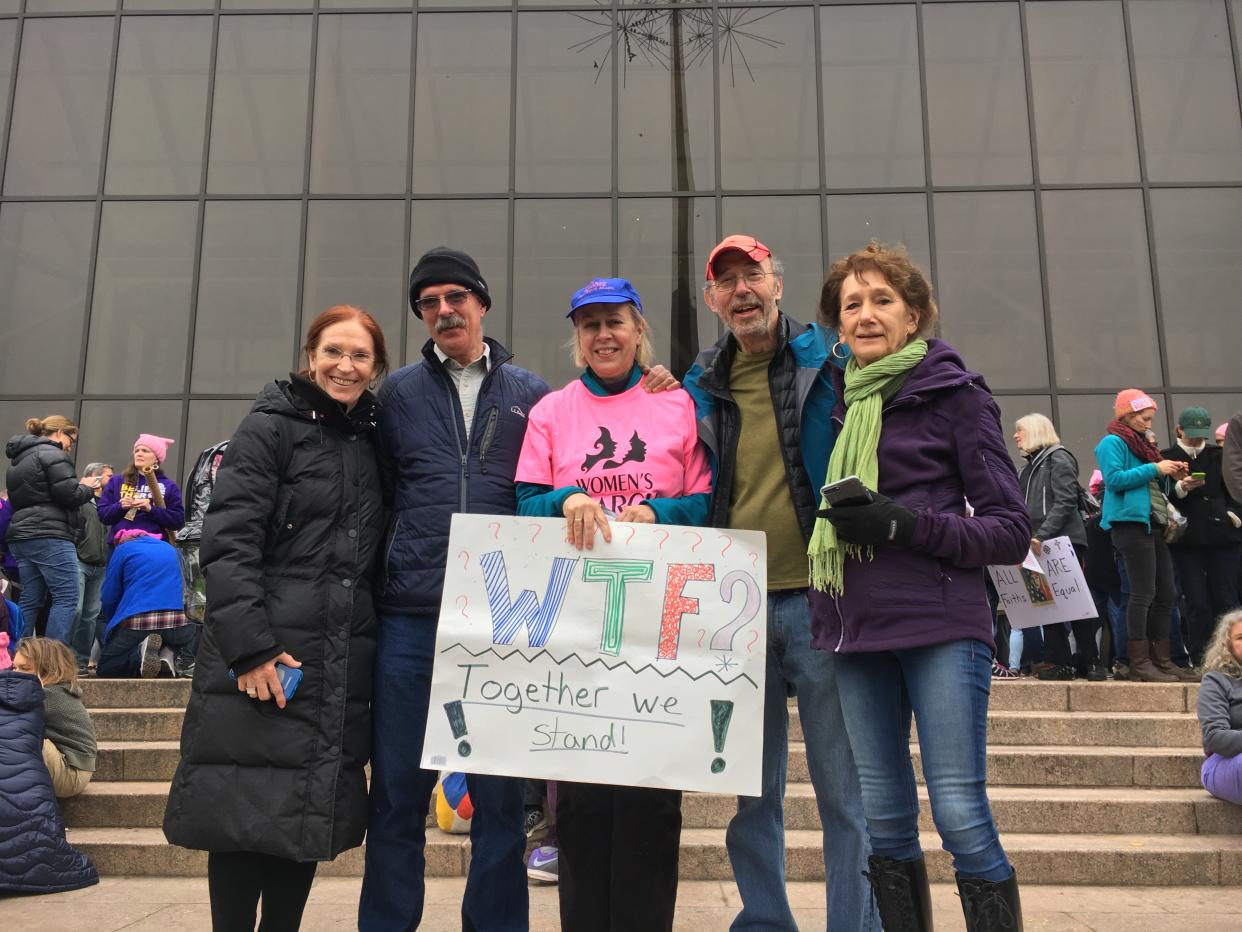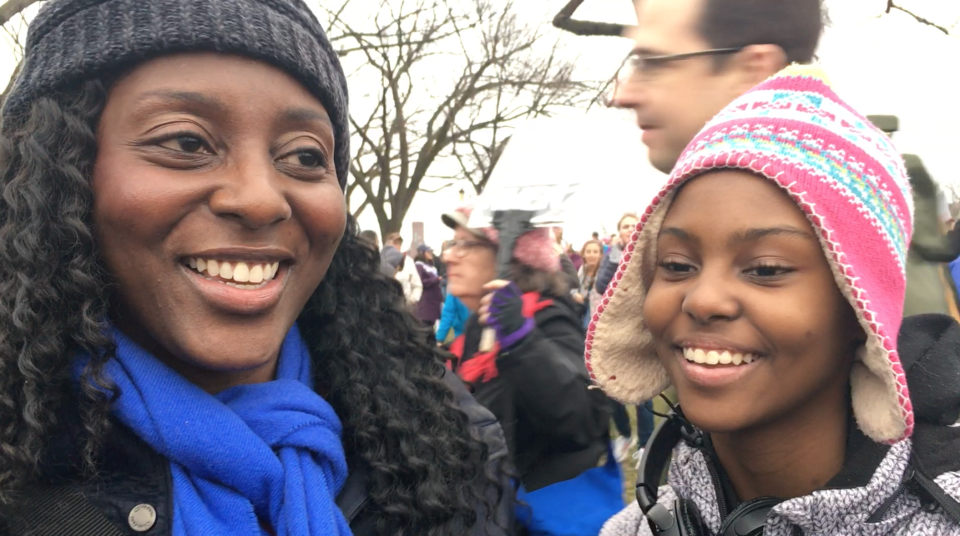Roosevelt’s Great-Granddaughter at Women's March


Anna Fierst, 61, woke up early Saturday in Washington, D.C., with a fire in her chest, the intensity of which she said she hadn’t felt in years. And this one had a particularly weighty duty attached: to hand down what she learned during a lifetime of protests to younger generations. “Because now,” she said while eating breakfast at the Women’s National Democratic Club, “I see that same fire burning in them.”
It was only 7:30 a.m., and already the streets of Washington D.C were filling with three generations of angst, ambition, and aspiration. All people who - like Fierst - wanted to protest newly elected President Donald J. Trump and his agenda. “I am in awe,” Fierst gasped, as she made her way to secure a spot to watch the speeches near the National Air and Space Museum, along with her 24-year-old daughter, Sophie. “We used to do this all the time,” she said, watching the National Mall swell with handmade signs of heartbreak and hope. “In our family, we’ve always known the importance of bringing our daughters along because the work is never done.”
Fierst, born Anna Eleanor Seagraves, is the great-granddaughter of Franklin and Eleanor Roosevelt. The Women’s March, and the “low-level rage” she said inspired it, are reminders of one of her great-grandmother's most famous quotes: “A woman is like a tea bag; you never know how strong it is until it's in hot water.”
By 11 a.m., that water was scalding.
[related id='340fc070-866e-43b1-82ec-ff384bb653db' align='left'][/related]
“I see lessons happening across the generations,” said Ceci Hall, who helped organize the 673 Sister Marches, the global solidarity events inspired by the Washington protest. “I think young people are underestimated big time, and I’m seeing young people showing us how to get back to good old-fashioned connection. They realize the value of people connecting.”
Na’Dia Raines, 13, from Alexandria, Virginia, is one of those young people. “It definitely makes me a lot more happy and a lot more at ease to know there are so many people who care about others," she explained while marching with her mom Jaeda, 39, who called the day one of the most important in their lives.

“I always try to lead by example with my daughter,” said Jaeda. “I hope that she sees that her mom is willing to walk out the door, stand with the people, and make change. This is how change happens … she doesn’t have to sit quietly and let things happen to her. She can be the change she wants to see in the world.”
But while the Women’s March was a real-world lesson in political participation and peaceful protest for tweens, teens, and young adults, for those in their 30s and 40s who were protesting for the first time, it was a wakeup call to their own privilege.
“My mother was so upset by the results of the election,” said 49-year-old Inga Bruggeman. “I knew that sitting home and feeling powerless was not an option.” Bruggeman came to D.C. from Reno, Nevada, meeting up with her 80-year-old mother Phyllis and sister Mieke who traveled from Portland, Oregon. The Women’s March was the first time any of them had taken to the streets for political change.
“In a perverse way, the Trump election is a good thing for getting people involved again,” Anna Fierst argued. “There’s the realization that everything we’ve gained over the years could disappear if we don’t motivate ourselves to get out and keep fighting.”
“Sometimes,” Fierst added, “you get the most progress during the bleakest times because it wakes people up.”
[related id='7d226a02-ec76-456d-98d1-8c3438bf0292' align='left'][/related]
There’s no sign that the people or the movement behind the Women's March plan to rest either. According to a new report by the U.S. Institute of Peace, mass participation is part of what makes nonviolent movements so successful. This is particularly so when women are included, the report adds, "because greater female inclusion leads to more sustainable peace." The Women’s March had that in spades - 3 million people are estimated to have marched in nearly 700 cities around the world. Organizers say those huge numbers are just part of the story. The momentum won’t stop, they say, because of the deep connections that have been forged between and among organizations and activists. “There are partnerships and alliances that have been built during the Women’s March planning,” said 673 Sister Marches organizer Hall. “Those partnerships are already being leveraged to get people plugged in at the community, state and national levels.”
“The big question is what will happen tomorrow,” echoed 63-year-old Mary*, who had left Philadelphia on a bus at 5:45 a.m. to meet her 36-year-old daughter, a diplomat temporarily living in D.C.
“It’s good to live in the moment, but we need to be thinking about tomorrow and the day after tomorrow,” her daughter added; she works at the State Department, now tasked to carry out President Donald Trump’s foreign policy in some of the most fragile corners of the world. “We can’t just stop at the end of the march. The end has to be the beginning.”
[related id='b8cacbe8-3c95-4481-958f-827feffac8f6' align='left'][/related]
Thirteen-year-old Na’Dia and her mom Jaeda are prepared. They plan to work side by side with local organizations focused on equal rights in their hometown of Alexandria, Virginia. “We need to let our voice be heard - not just today but every day,” Jaeda said. “And I think as much as I want my daughter to learn from me, I can learn from her too.”
*Mary's name has been changed to protect her daughter's anonymity.
Beth Murphy is the director of films at The GroundTruth Project and founder of Principle Pictures. Lauren Bohn is The GroundTruth Project’s Middle East correspondent based in Istanbul and co-founder of Foreign Policy Interrupted.
You Might Also Like

